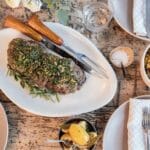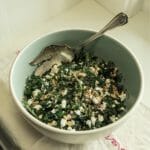Recipes From Willow Spring Ranch
Over the past decade, Rich and Katy Harjes have hosted dozens of festive meals at Willow Spring Ranch, their organic lamb operation in Belgrade, Montana.
Recipes From Willow Spring Ranch
Over the past decade, Rich and Katy Harjes have hosted dozens of festive meals at Willow Spring Ranch, their organic lamb operation in Belgrade, Montana.

“When we first got started, Katy and I threw dinner parties to lure friends from Bozeman to help us move sheep from one pasture to another,” says Rich. At this particular feast, however, no one had to sing, or herd, for his or her supper – though Andleeb Dawood, the proprietor of Bozeman’s Saffron Table, did pitch in by frying up her signature lamb samosas. Wyatt Nelson came straight from the city’s Community Food Co-op, while neighbor Sheryl Ott simply arrived via snowshoes. No big surprise: Katy, a former caterer, made a leg of lamb the centerpiece of the night’s menu, pairing the boneless cut with shredded butternut squash, a homegrown kale and parsley salad, and a buttery almond cake. “There’s a certain pride in showing people that you raised the food they’re eating with great care,” she says.
“It’s important not to rush this recipe,” says Bozeman restaurateur Andleeb Dawood, who contributed the meal’s appetizer. “You want to really caramelize the onions, and add the spices slowly so the meat filling fully absorbs them.”
Heat oil in a large skillet over medium heat. Add cumin seeds and cook until fragrant and starting to sizzle, 1 to 2 minutes. Add onion and cook, stirring occasionally, until caramelized and dark brown, about 20 minutes. Add lamb, garlic, and ginger and cook, stirring frequently, until most of the liquid has evaporated, 10 to 15 minutes. Add garam masala and cook, stirring frequently, for 5 minutes more. Add salt, coriander, cayenne, and turmeric and cook for 2 minutes more; stir in tomato and reduce heat to low. Place Anaheim pepper in center of meat mixture; cover and simmer until tomato dissolves, about 10 minutes. Stir in peas and cook, uncovered, until peas are cooked through but still bright green, 5 minutes. Remove from heat and drain any remaining fat from pan; discard Anaheim pepper. Allow meat filling to cool completely.
Meanwhile, in a small bowl, stir together flour and 1 to 2 teaspoons water to create a paste; set aside. Fold and fill the wonton wrappers to form the samosas (see “How to Fold Samosas,” below).
Place a wok or medium, high-sided pot fitted with a candy thermometer over medium-high heat; add about 3 inches of oil and bring to 350°F. Carefully place half of samosas in the hot oil, making sure not to crowd the pan, and fry, flipping once, until crispy and dark golden brown, about 8 minutes. Using a slotted spoon, transfer samosas to a paper-towel-lined plate. Repeat with remaining samosas. Transfer to a platter. Garnish with lemon zest, if using, and serve hot with Cilantro-Mint Chutney and Raita.
How to Fold Samosas
Place half a wonton wrapper on a flat surface. Fold top right-hand corner down and over to form a triangle.
Bring top lefthand corner of wrapper down to bottom right corner to create a pocket.
Using your thumb to keep the folds in place, carefully spoon about 1½ tablespoons of filling into the wonton pocket, taking care not to rip the wrapper.
Dip a pastry brush in reserved flour paste and lightly brush flap of the open pocket to prepare it for sealing.
Fold prepared edge over, pressing down to seal pocket and form a triangle-shaped samosa. Repeat with the remaining wrappers.
Cliantro-Mint Chutney
In a blender, combine 1 cup each cilantro and mint leaves (about 6 ounces of each); 2 serrano peppers, seeds and stems removed, finely chopped; 2 tablespoons fresh lemon juice; 1 tablespoon finely chopped garlic; 1 tablespoon toasted cumin seeds; ¾ tablespoon salt; and ½ cup water. Process on high speed until a thick sauce forms (you should be able to spoon it onto a plate), adding more water, a tablespoon at a time, as needed, to reach desired consistency. Taste and adjust salt, if needed. Store refrigerated for up to 3 days; garnish with a pinch of lemon zest, if desired, before serving. Makes about 1 cup.
Raita
In a blender, combine 1 quart whole-milk yogurt; 1 finely chopped medium red onion (about 1 cup); 1 cup finely chopped cilantro leaves, plus a few stems; ½ cup finely chopped mint leaves; ¼ cup fresh lemon juice; 1 tablespoon ground coriander; and 1 teaspoon salt. Process on high speed until sauce is smooth and creamy. Store refrigerated for up to a week. Makes about 1½ quarts.

Katy prefers a boneless, or butterflied, leg of lamb for roasting, because the cut cooks faster and more evenly. Although the brine brings subtle flavor to the meat, you can skip this step if pressed for time.
Approximately 8 hours before you plan to serve the lamb, prepare brine: In a large stockpot over medium heat, bring 2 quarts water, sugar, salt, lemon juice, spent lemon quarters, peppercorns, fennel seeds, and bay leaves to a simmer, stirring until sugar and salt dissolve. Place pot in the refrigerator to cool.
Meanwhile, carefully trim excess fat from lamb, making sure the meat stays in one piece. Submerge the meat in the cooled brine and return to the refrigerator for at least 4 hours but no more than 6.
Remove lamb from brine and pat dry with paper towels. Transfer to a wire rack set over a rimmed baking sheet; let any additional liquid drain and allow meat to return to room temperature, about 1 hour.
Meanwhile, make the gremolata: In a food processor, pulse together parsley, oil, rosemary, shallots, and lemon zest until combined but still coarse in texture.
Preheat oven to 425°F. Meanwhile, place lamb on a cutting board with the side that was on the bone facing up (it will have a more irregular surface). Season lamb with pepper, then rub with two-thirds of the gremolata. Fold meat in half, enclosing gremolata, then rub remaining gremolata on the outside. Using butcher’s twine, tie lamb in three places to secure it in a log shape, then place it in a roasting pan and cook for 35 to 40 minutes, or until an instant-read thermometer inserted into thickest part of meat reads 130°F for rare or 135°F for medium-rare. Transfer lamb to a clean cutting board and allow to rest for 15 minutes.
Remove twine and cut meat into ¼-inch-thick slices; transfer to a platter, garnish with rosemary sprigs, and serve warm with preserved lemon wedges on the side.

No mush here: Sautéeing the coarsely grated squash in coconut oil results in an almost al dente texture, and the seasonings – cumin, coriander, nigella, and cinnamon – elevate this simple side to exotic fare. This side dish can be served hot or at room temperature.
Heat oil in a large cast-iron skillet over medium-high heat. Add cumin seeds and toast until fragrant, 1 to 2 minutes. Add onion and cook, stirring frequently, until tender and lightly browned, about 8 minutes. Add squash and reduce heat to medium; cook for 5 minutes, stirring frequently to prevent squash from sticking. Stir in coconut, ¼ cup water, coriander, and nigella; if mixture is too dry, add up to another ¼ cup water, a tablespoon at a time. Add cinnamon stick and bay leaves, then reduce heat to a simmer and continue cooking, stirring occasionally, until squash is just tender, about 20 minutes. Season to taste with salt.

“Parsley is totally underrated,” says Katy, who combines a flat-leaf variety with kale for a practically wilt-proof salad that improves if tossed with the Middle Eastern”“inspired dressing up to a day in advance.
In a large bowl, combine kale, parsley, feta, and walnuts. In a small jar, combine oil, shallot, lemon juice, za’atar, coriander, allspice, and cumin; shake well to emulsify. Add a few tablespoons of dressing to salad and mix well with your hands; continue to add dressing and toss until desired flavor has been achieved. Season to taste with salt and pepper.

“The cake has a tendency to sink in the middle as it cools, so don’t worry if it looks a little wonky,” advises Katy. “What it lacks in beauty, it more than makes up for in taste.” The Brandied Cherries require advance planning: It takes six weeks in the fridge to get perfectly boozy fruit. “I use local Flathead cherries, such as ‘Lambert’ or ‘Lapin,’” says Katy.” But any firm, fleshy, dark sweet cherry works.”
Brandied Cherries
Preheat oven to 350°F. Meanwhile, generously butter bottom and sides of a 9-inch-round springform pan. In a small bowl, mix sour cream with baking soda. In a medium bowl, sift flour and salt together. Set aside prepared pan and both bowls.
In a large bowl, using an electric mixer on high speed, cream remaining butter and granulated sugar until pale yellow and fluffy, 3 to 4 minutes. Reduce mixer speed to medium and add almond paste, a little at a time, as you continue beating mixture for 8 minutes more. Add egg yolks, one at a time, and continue beating until incorporated. (Batter will look curdled.) Add almond extract and reserved sour cream mixture and continue beating until incorporated. Reduce mixer speed to low and gradually add reserved flour mixture, beating just until blended. Pour batter into prepared pan and spread to evenly distribute.
Bake until top of cake is golden brown and returns to its original shape when pressed, and edge separates from side of pan, about 1 hour. Remove cake from pan and allow to cool on a wire rack. Right before serving, dust top with confectioners’ sugar. Serve with Brandied Cherries or your favorite fruit jam.
Brandied Cherries
In a medium saucepan over medium-high heat, bring ½ cup water, sugar, lemon juice, cardamom pods, cloves, allspice, cinnamon stick, and vanilla bean to a boil. Reduce heat to low and simmer until slightly reduced and thickened, about 10 minutes. Turn off heat. Stir in brandy and cherries.
Using a slotted spoon, transfer cherries to jar. Pour liquid over fruit to cover and screw on lid. Place jar in refrigerator and allow cherries to marinate for 6 weeks before using.
SaveSave
SaveSave
Follow us
This work is licensed under a Creative Commons Attribution-NoDerivatives 4.0 International License.
Want to republish a Modern Farmer story?
We are happy for Modern Farmer stories to be shared, and encourage you to republish our articles for your audience. When doing so, we ask that you follow these guidelines:
Please credit us and our writers
For the author byline, please use “Author Name, Modern Farmer.” At the top of our stories, if on the web, please include this text and link: “This story was originally published by Modern Farmer.”
Please make sure to include a link back to either our home page or the article URL.
At the bottom of the story, please include the following text:
“Modern Farmer is a nonprofit initiative dedicated to raising awareness and catalyzing action at the intersection of food, agriculture, and society. Read more at <link>Modern Farmer</link>.”
Use our widget
We’d like to be able to track our stories, so we ask that if you republish our content, you do so using our widget (located on the left hand side of the article). The HTML code has a built-in tracker that tells us the data and domain where the story was published, as well as view counts.
Check the image requirements
It’s your responsibility to confirm you're licensed to republish images in our articles. Some images, such as those from commercial providers, don't allow their images to be republished without permission or payment. Copyright terms are generally listed in the image caption and attribution. You are welcome to omit our images or substitute with your own. Charts and interactive graphics follow the same rules.
Don’t change too much. Or, ask us first.
Articles must be republished in their entirety. It’s okay to change references to time (“today” to “yesterday”) or location (“Iowa City, IA” to “here”). But please keep everything else the same.
If you feel strongly that a more material edit needs to be made, get in touch with us at [email protected]. We’re happy to discuss it with the original author, but we must have prior approval for changes before publication.
Special cases
Extracts. You may run the first few lines or paragraphs of the article and then say: “Read the full article at Modern Farmer” with a link back to the original article.
Quotes. You may quote authors provided you include a link back to the article URL.
Translations. These require writer approval. To inquire about translation of a Modern Farmer article, contact us at [email protected]
Signed consent / copyright release forms. These are not required, provided you are following these guidelines.
Print. Articles can be republished in print under these same rules, with the exception that you do not need to include the links.
Tag us
When sharing the story on social media, please tag us using the following: - Twitter (@ModFarm) - Facebook (@ModernFarmerMedia) - Instagram (@modfarm)
Use our content respectfully
Modern Farmer is a nonprofit and as such we share our content for free and in good faith in order to reach new audiences. Respectfully,
No selling ads against our stories. It’s okay to put our stories on pages with ads.
Don’t republish our material wholesale, or automatically; you need to select stories to be republished individually.
You have no rights to sell, license, syndicate, or otherwise represent yourself as the authorized owner of our material to any third parties. This means that you cannot actively publish or submit our work for syndication to third party platforms or apps like Apple News or Google News. We understand that publishers cannot fully control when certain third parties automatically summarize or crawl content from publishers’ own sites.
Keep in touch
We want to hear from you if you love Modern Farmer content, have a collaboration idea, or anything else to share. As a nonprofit outlet, we work in service of our community and are always open to comments, feedback, and ideas. Contact us at [email protected].by Monica Michael Willis, Modern Farmer
January 5, 2018
Modern Farmer Weekly
Solutions Hub
Innovations, ideas and inspiration. Actionable solutions for a resilient food system.
ExploreShare With Us
We want to hear from Modern Farmer readers who have thoughtful commentary, actionable solutions, or helpful ideas to share.
SubmitNecessary cookies are absolutely essential for the website to function properly. This category only includes cookies that ensures basic functionalities and security features of the website. These cookies do not store any personal information.
Any cookies that may not be particularly necessary for the website to function and are used specifically to collect user personal data via analytics, ads, other embedded contents are termed as non-necessary cookies.